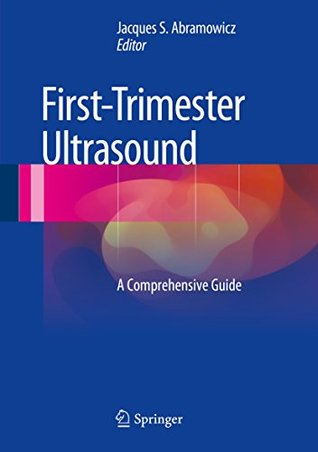Read online First-Trimester Ultrasound: A Comprehensive Guide - Jacques S Abramowicz | PDF
Related searches:
In the first trimester, doctors usually use a transvaginal rather than abdominal ultrasound.
First trimester screening, also called the first trimester combined test, has two steps: a blood test to measure levels of two pregnancy-specific substances in the mother's blood — pregnancy-associated plasma protein-a (papp-a) and human chorionic gonadotropin (hcg) an ultrasound exam to measure the size of the clear space in the tissue at the back of the baby's neck (nuchal translucency).
Stay up to date with recent advances in the use of ultrasound in early gestation with this comprehensive, full-color reference. First trimester ultrasound diagnosis of fetal abnormalities is an authoritative, systematic guide to the role of first trimester ultrasound in pregnancy risk assessment and the early detection of fetal malformations. High-quality illustrations and numerous tables throughout enhance readability, making this text an excellent daily resource in clinical practice.
4 oct 2016 monitoring a low-risk pregnancy with ultrasound in the first trimester might not qualify, webb noted.
In many parts of the world, first trimester ultrasound examination is often indicationdriven (1) - unlike the “routine” second trimester ultrasound examination that is commonly performed for fetal anatomic assessment. Indications for the first trimester ultrasound examination vary but typically are related to maternal symptoms.
Although many indications exist for first-trimester ultrasound in pregnancy, more emphasis has been placed on assessment of fetal anatomy recently. In turn, congenital diagnoses can also be made earlier in pregnancy, raising the question of whether anatomic assessment in the first trimester is one of choice or obligation.
Women with certain types of high-risk pregnancies should get multiple ultrasounds. Everyone should get the second trimester ultrasound, which is medically necessary and can save lives. And nobody with a low-risk pregnancy should be getting a first trimester ultrasound, unless there’s a specific reason for the procedure.
31 jan 2020 gestational sac (gs), yolk sac (ys), crown-rump length (crl), and heart rate (hr ) are the parameters measured to evaluate early pregnancy.
First trimester ultrasound helps determine important next steps in prenatal care. First trimester ultrasounds are done for a variety of reasons. Sometimes patients may experience spotting or cramping during their first trimester.
Do you know what to expect at your first trimester ultrasound? we've partnered with the american institute of ultrasound medicine (aium), johns hopkins, and the march of dimes to create this unique.
5 dec 2019 do you know what to expect in the first trimester of pregnancy? we've partnered with the american institute of ultrasound medicine (aium),.
Anembryonic pregnancy is a form of failed pregnancy defined as a gs in which the embryo fails to develop.
6 nov 2020 the first fetal ultrasound is usually done during the first trimester to confirm the pregnancy and estimate how long you've been pregnant.
For a more detailed look at the stages of the first trimester see: ultrasound findings in early pregnancy. Ultrasound during this period is predominantly concerned with the following clinical issues: confirming intrauterine pregnancy (iup) early features supportive of an intrauterine pregnancy. Double decidual sac sign; intradecidual sign; double bleb sign.
First trimester ultrasound is recommended for assessment of threatened abortion to document fetal viability (ii-2b) or for incomplete abortion to identify.
In the first trimester, an early ultrasound is often a routine part of prenatal care between 6 to 9 weeks of pregnancy. However a first-trimester ultrasound isn’t standard practice, because it’s still too early for your practitioner to see your baby in detail. Most practitioners wait until at least 6 weeks to perform a first pregnancy ultrasound.
Studies evaluating tests of first trimester ultrasound screening, alone or in combination with first trimester serum tests (up to 14 weeks' gestation) for down's syndrome, compared with a reference standard, either chromosomal verification or macroscopic postnatal inspection.
A first-trimester ultrasound is usually done 7 to 8 weeks from the first day of your last menstrual period, says rebecca jackson, md, assistant professor of obstetrics and gynecology at the sidney.
Ultrasound is essentially used for assessing gestational age, current viability and maternal wellbeing. Ultrasound is a valuable diagnostic tool in assessing the following indications; unsure of dates; vaginal bleeding; pelvic pain; exclude an ectopic pregnancy; maternal past history; threatened miscarriage; nuchal translucency (11-14 weeks� crl 45-84mm).
First trimester ultrasound examination is done to evaluate the presence, size and location of the pregnancy, determine the number of fetuses, and estimate how long you've been pregnant (gestational age). Ultrasound can also be used for first trimester genetic screening, as well as screening for abnormalities of your uterus or cervix.
This book offers a unique and focused study of the use of ultrasound during the first trimester, a critical time in a fetus' development.
The earlier in pregnancy a scan is performed, the more accurate the age assignment from crown rump length.
Pictures of the pregnant uterus are taken with sound waves, not x- rays.
Usually two ultrasound scans are done in the first trimester: dating and viability scan: between 6 th to 9 th; morphology or nt (nuchal translucency) scan: between 11 th to 13 th; types of scans: the ultrasound scans done before the 10 th week are usually trans-vaginal scans. The fetus is too small to be seen through the abdomen, so it is seen through the vagina.

Post Your Comments: